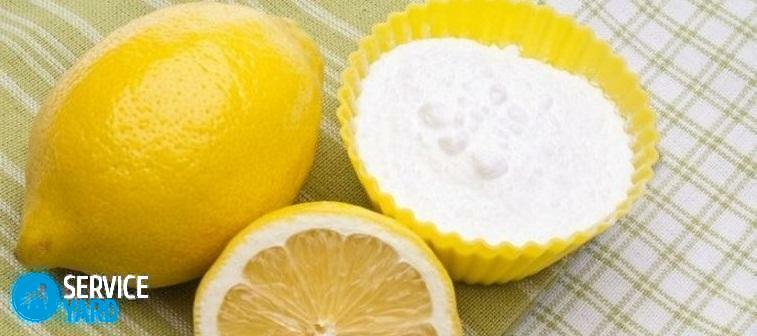Most housewives among kitchen utensils there cauldron. Universal dishes, can be used not only at the plate, but also at the stake. Thick-walled product is practical, convenient, but loses the original purity over time. Wash the cauldron after the cooked meal is not easy. Depending on the material items for care utensils will be different.
Dishes cooked in a cauldron, very delicious, fragrant.
Content
- 1 What is cauldron
- 2 How to clean the kettle from scale depending on the material
- 2.1 How to clean a cast-iron cauldron
- 2.2 How to clean aluminum kettle
- 2.3 Cleaning stainless steel cauldron
- 2.4 Nuances cleaning rust
- 3 Which means you can clean the kettle at home
- 3.1 Clay and soda
- 3.2 Activated carbon
- 3.3 Lemon acid
- 3.4 Glue and soap
- 3.5 Vinegar in combination with salt and soda
- 3.6 Clean with sand
- 3.7 Modern chemicals
- 4 How to recover non-stick layer after cleaning
- 4.1 How to clean after cooking kettle
- 5 Helpful hints for the care and prevention of fouling
- 6 conclusion
- 7 VIDEO: How to quickly and easily clean the kettle from scale.
What is cauldron
Kazan - cast metal pot hemispherical shape with a semicircular bottom. Product feature is the uniform heating of the walls that retain heat for a long time inside the tank. Thickness proved prevents scorching of food, but its rounded shape contributes to lower absorption of food oils and longing. As a result, products remain the most useful elements. Well suited for dishes requiring long extinguishing.
Manufacturers offer various models of iron utensils.
Basically, the cauldron is made of two forms: in the form of a hemisphere with a flat bottom. The first option is suitable for cooking on an open fire, as it can be used only with a special tripod. The second option in demand at home, it is conveniently placed on the hob.
The thick-walled cookware is convenient, practical, but when used loses its former cleanliness outside, inside.
How to clean the kettle from scale depending on the material
In the process of cooking in a cauldron does not avoid the appearance of soot and carbon deposits. And if you do not abide by the rules of care, the rust and cracks. Not knowing all the nuances of cleaning proved made of different materials, resulting in the loss of the positive properties of the product.
For special round shape traditional dishes of Asia appreciate chefs all over the world.
How to clean a cast-iron cauldron
To wash proved iron is used a plurality of methods. Material should be treated with respect, as prone to split on impact. Do not use hard brushes and abrasives.
Despite the fact that the rounded walls rarely burn up all the food particles and grease sometimes take a strong liking to the surface of the dish. To clean the internal walls of the kettle completely fill the prepared solution and put on the fire. The detergent is brought to a boil and maintained at heat for about 20 minutes. This time is sufficient to snuff softened.
Although burn up the rounded wall less than a straight surface of the pan, but the fat is still a strong liking to the walls, sometimes burn up pieces of food.
To clean the product on the outside, it is completely put into a deep container and heated. After boiling the leaves well, not only soot and fat, but also adhering tar.
Important! Do not be washed in the dishwasher.
How to clean aluminum kettle
aluminum surface less porous, so it is easier to wash off contaminants. It is important to consider one caveat - the oxide film is formed on exposure to air. To the surface is not oxidized, the aluminum kettle may be cleaned with a soft steel wool.
Suitably washing detergents not containing oxalic acid from it dims alloy, the upper oxide layer becomes flabby.
Not forbidden to wash in the dishwasher, use cleaners with abrasives.
Important! Do not use household chemicals to the content of oxalic acid. From it the oxide layer becomes looser, and dims the alloy.
Cleaning stainless steel cauldron
Observing certain requirements care, proved useful properties of stainless steel are retained for a long time. How to wash the product:
- Avoid detergents with abrasives, coarse metal sponges and brushes (scratch coating);
- not to use products containing chlorine;
- washes dishes with liquid means (recommended buy special household chemicals intended for the care of a metal surface);
- not allowed puncturing products (sharp temperature drop destroys the integrity of the oxide film layer covering the upper wall);
- Can be washed in the dishwasher.
Can be put into the washing machine, crockery functionality will not change.
Nuances cleaning rust
Improper storage results in a red-headed flying - rust. To remove dishes previously soaked in a solution of water and vinegar in equal proportions. You can add a special chemistry, corrosive rust. the following handy tools suitable for cleaning the plaque:
- medium-grained and coarse-grained sandpaper, steel wool (help is only slightly dirty);
- Drill with a flat nozzle (after use of the instrument is necessary to remove corrosion metal then using phosphoric acid or oxalic acid);
- sander (removes rusty layer after a few minutes, should be done by people with professional skills).
It requires bluing - oil firing, corrosion protection and create non-stick layer.
With large layer unpleasant plaque copes digestion. To do this in a bucket with 6 L of water is added a salt pack. Place the kettle and cook 8 hours on a low heat.
Cast iron does not like scratching from this oily layer is destroyed, open micropores are clogged with particles in the products.
Remove rust with proved possible by means of special funds intended to care for the oven. You can use folk remedies. Minimum plaque purified potato removed, then washed well with warm water and dried.
Peeled potatoes help to remove plaque from the cauldron.
Which means you can clean the kettle at home
There are several ways to remove soot and carbon deposits from the cauldron, which can easily take advantage of every woman. It is important to know how to clean the kettle from scale correctly.
Clay and soda
To prepare the solution needed to take water (volume determined by the dimensions dishwashing container must be filled to the brim) 1 tube silicate or paper glue and soda (250 g).
All components are connected and well mixed.
Cauldron filled with solution is placed on a medium heat and simmer for about 1 hour. After the elapsed time from the pot liquid cooled, and then washed with a soft sponge and a detergent for tableware.
For reference! The method is suitable for aluminum and cast iron products.
Activated carbon
Drug copes with the remnants of burnt food. The tablets are used in particulate form (their number depends on the degree of contamination, is usually sufficient plates 1-2).
Activated carbon to clean the cauldron.
Uniform crumbs fall asleep of the boiler and three washcloth. Part of the pellets should be laid on the bottom and leave for 2 h. Carbon residues wash off liquid agent. All contaminated waste from the walls of the dishes themselves.
Lemon acid
The purification method does not require large expenditures. All you need - to buy citric acid. To obtain a solution, 40 g of the powder to be connected to 1 liter of water. The resulting liquid is poured into the kettle, put on a little fire and tormented about 30 minutes. Remains of soot remove with a sponge.
Plaque is easily removed by means of citric acid.
Glue and soap
As is well known, soap cope with any pollution. For greater effect, add stationery glue. To purify the product on the inside and outside, it is necessary to take a piece of soap (72%) and a PVA glue (50-65 g).
Another home method of how to clean the kettle, not putting much effort.
To remove the carbon from the outer and inner sides of the dishes were placed into the boiler large vessel filled with glue and soap chips. After that, put on a slow fire and boil for 3 hours. Boiling soapy water will help soften the deposit and it is easy to remove from the walls of the cauldron.
For reference! Do not forget about the harmful vapors of glue, during the procedure, it is desirable to ventilate the room.
Vinegar in combination with salt and soda
The following components must be prepared for the cleaning solution:
- table or apple vinegar - 200 ml;
- salt - 2 tbsp. spoons;
- ash - 2 tbsp. spoon.
After just need to wash the cauldron and ignited it with oil.
Fill the kettle water, adding salt and vinegar. Bring to the boil, then go to sleep soda. Boil the solution for half an hour. We follow the foam, which is formed by the reaction of vinegar and baking soda.
Clean with sand
To use this method, you will need to find a dry river sand. They dishes brimming and pierced to simmer for at least 8-10 hours. The sand mix periodically. After this time, pour the contents of the boiler. Existing pollution should move easily.
After the procedure, the boiler is washed with water and wiped with clean dry cloth, so soot is removed from burnt fat.
Modern chemicals
Chemical cleaning agents - one of the easiest options in the fight against carbon deposits. Manufacturers offer a wide range of products for the care of different materials.
Print the pollution will help ordinary household chemicals.
Household chemicals must be designed to remove contaminants from the metal complex (preferably proved). Funds require careful use. They must be thoroughly washed off with water, to the remains of funds did not get to eat.
Of modern chemistry for the cast-iron cookware is suitable Domestos. Means universal, suitable for removal of contaminants not only in the bathroom and toilet rooms, but with products from iron.
After completing the steps, utensils will be almost like new, and you can continue to cook without fear that products will be burnt.
Important! During cleaning do not neglect the means of protection for the skin of the hands, eyes and respiratory tract.
How to recover non-stick layer after cleaning
Often, together with the protective layer removed with coke. In this procedure, we need only boilers of ferrous metal. Return oily protection in several ways, but the most simple of them - calcination.
Things To Do:
- Rinse the boiler;
- completely dry;
- to put on the walls of animal fat;
- put on for 5 minutes over high heat (to burn fat);
- cool and rinse with water.
By oil quenching iron becomes shiny, shiny.
Kazan iron tempered at stake with oil. After its complete burning boiler filled with water and heated.
How to clean after cooking kettle
Knowledge of how to effectively clean metallic kettle after cooking, to help keep it a long time performance. Prepared properly in a special pot washing is not needed.
Before you wash the cauldron, liberating it from food residues. Pour into bowl water, put on fire to boiling and allowed to cool. After that liberating from the liquid container, liquid detergent wash and a soft side of the sponge.
The treated cauldron never will burn the food is delicious, useful.
Inner and outer sides dishwashing wipe dry, put on the wall of a small amount of oil and with an open lid put on the storage cabinet.
Helpful hints for the care and prevention of fouling
How to clean the kettle? The most important thing is to remember every woman, the boiler always after washing wipe dry. If you leave bowl with a damp, rust stains can not be avoided.
With constant use of roasting dishes are held at least twice a year.
Frequent use of the product involves coating the inner walls of the proved oil layer. So the food is not burnt.
The service life of a thick-walled metal containers are not limited.
To a place of storage of utensils should air flow freely. The bowler can not be tightly covered with a lid if its inner surface is covered with oil. Storage cabinet must be dry.
Stored pig oiled cloth or paper.
Before the first use of the product requires a piercing in the preheated oven. Thus no pre-warmed oven, the temperature rise should occur gradually (at least 200 ° C). After cooking cauldron immediately washed from food residues, soak it for a long time can not.
Kazan after cleaning is required to wash with warm water and a detergent.
conclusion
Clean the kettle from scale and rust in the home is not difficult, if you study the simple rules of care. Careful and correct use of the boiler will extend for many years, his performance properties, and prepared dishes will please the rich aroma and taste.
Careful handling is also a guarantee that the kettle will last longer.



